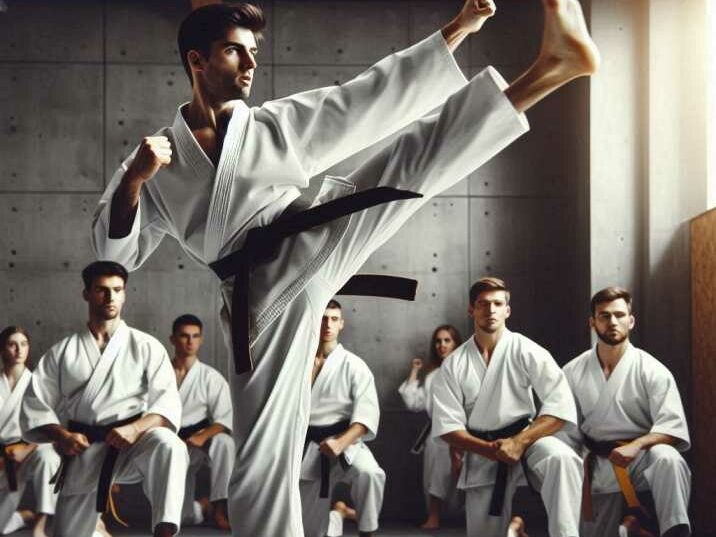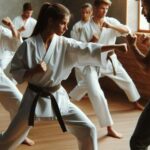Martial arts are a great way to stay active, learn self-defense, and build confidence. From karate to taekwondo, each style offers unique benefits and challenges. If you’re curious about how to get started with basic martial arts, this guide will provide you with everything you need to know. We’ll cover different types of martial arts, how to choose the right one for you, and some basic moves you can practice at home. By the end, you’ll be ready to take your first step into the exciting world of martial arts!

Introduction to Martial Arts
Table of Contents
Martial arts are systems of self-defense and combat training that have been practiced for thousands of years. These arts originated in different parts of the world and have been influenced by culture, tradition, and practical needs. Today, martial arts are popular for fitness, discipline, and self-defense.
What Are Martial Arts?
Martial arts are practices that combine physical exercises with mental focus and discipline. They are often associated with Asian cultures, but many styles have roots in other parts of the world. People practice martial arts for various reasons, such as improving physical fitness, learning self-defense, and boosting mental strength.
Different Types of Martial Arts
There are many types of martial arts, each with unique techniques and philosophies. Here are a few popular ones:
- Karate: Originating from Japan, karate focuses on striking techniques, including punches, kicks, and knee strikes.
- Taekwondo: A Korean martial art known for its high, fast kicks and spinning techniques.
- Judo: Also from Japan, judo emphasizes throwing opponents and grappling on the ground.
- Kung Fu: A Chinese martial art that includes a wide range of styles focusing on strength, speed, and flexibility.
- Brazilian Jiu-Jitsu: This martial art focuses on ground fighting and submission holds.
- Muay Thai: Known as the “Art of Eight Limbs,” this Thai martial art uses punches, kicks, elbows, and knees.
Benefits of Learning Martial Arts
Learning martial arts offers numerous benefits beyond self-defense. These include:
- Physical Fitness: Improves strength, flexibility, and endurance.
- Discipline: Teaches focus and self-control.
- Confidence: Builds self-esteem through mastery of techniques.
- Stress Relief: Provides an outlet for releasing tension and anxiety.
Choosing the Right Martial Art for You
Choosing the right martial art depends on your interests, goals, and physical abilities. Here are some factors to consider:
Consider Your Goals
Think about what you want to achieve by learning martial arts. Do you want to improve your fitness, learn self-defense, or compete in tournaments? Your goals will help guide your choice.
Explore Different Styles
Attend classes or watch videos of different martial arts to see which ones interest you the most. Each style has unique techniques and philosophies, so finding one that resonates with you is essential.
Evaluate Your Physical Abilities
Some martial arts require more physical agility and flexibility than others. Consider your strengths and weaknesses to find a martial art that suits your abilities.
Try a Class
Most martial arts schools offer trial classes, which are a great way to experience the style and see if it’s a good fit for you. Don’t be afraid to try multiple classes before making a decision.
Basic Martial Arts Techniques to Learn
Once you’ve chosen a martial art, you’ll want to start practicing some basic techniques. Here are a few fundamental moves that are common across many styles:
Stances
A good stance is the foundation of any martial art. Here are some basic stances:
- Horse Stance: Stand with feet wide apart, knees bent, and back straight. This stance builds strength and stability.
- Front Stance: One foot forward, the other back, with knees bent. This stance provides balance and power for strikes.
Strikes
Striking techniques include punches and kicks. Here are a few basic ones:
- Jab: A quick, straight punch with your lead hand.
- Cross: A powerful punch with your rear hand.
- Front Kick: A kick with the ball of the foot, aimed at the opponent’s midsection.
Blocks
Blocking is essential for defending against attacks. Some basic blocks include:
- High Block: Raising your arm to protect your head from a strike.
- Low Block: Lowering your arm to deflect a kick or low punch.
Practicing at Home
You can practice many basic techniques at home. Here’s a simple routine to get you started:
- Warm up with light stretching and cardio.
- Practice stances, focusing on balance and stability.
- Work on striking techniques, using a punching bag or air punches.
- Practice blocking techniques, imagining different attacks to defend against.
Martial Arts Etiquette and Safety
Martial arts practice requires discipline and respect. Here are some key points to keep in mind:
Respect Your Instructors and Peers
Show respect by bowing or greeting your instructor and fellow students before and after class. Listen attentively and follow instructions carefully.
Wear Proper Attire
Wear comfortable, appropriate clothing for your martial art. Many styles have specific uniforms, such as a gi for karate or judo.
Practice Safety
Always practice with control and focus to avoid injury. Use protective gear when necessary and never push yourself beyond your limits.
Setting Goals and Tracking Progress
Setting goals and tracking your progress is essential to learning martial arts. Here are some tips:
Set SMART Goals
Set SMART goals that are Specific, Measurable, Achievable, Relevant, and Time-bound. For example, aim to learn a new technique every month or attend a certain number of classes each week.
Keep a Training Journal
Record your training sessions in a journal, noting what you learned, what you found challenging, and any improvements you notice. This can help you track your progress and stay motivated.
Celebrate Achievements
Celebrate your achievements, whether mastering a new technique or earning a new belt rank. Recognizing your progress will keep you motivated and inspired to continue learning.
Building Discipline and Focus Through Martial Arts
Martial arts are about more than just physical skills; they also teach discipline and focus. Here’s how:
Consistent Practice
Consistency is key to improvement. Set aside regular practice time and stick to it, even when you don’t feel like it.
Mindfulness and Meditation
Many martial arts incorporate mindfulness and meditation to improve focus and mental clarity. Spend a few minutes each day practicing deep breathing or meditation.
Overcoming Challenges
Martial arts training can be challenging, but facing these challenges head-on will build resilience and determination. Embrace difficulties as opportunities for growth.
How to Find a Martial Arts School
Finding the right martial arts school is crucial to your learning experience. Here’s how to choose a school that suits your needs:
Research Local Schools
Start by researching martial arts schools in your area. Look for schools that offer classes in the style you’re interested in and read reviews from other students.
Visit the School
Visit the school to see the facilities, meet the instructors, and observe a class. This will give you a sense of the school’s atmosphere and teaching style.
Ask Questions
Don’t hesitate to ask questions about the school’s curriculum, class structure, and instructor qualifications. A good school will be happy to provide this information.
Consider the Cost
Consider the cost of classes, uniforms, and any additional fees. Choose a school that fits your budget and offers good value for your investment.
The Importance of Patience and Persistence
Learning martial arts is a journey that requires patience and persistence. Here’s why these qualities are essential:
Mastery Takes Time
Becoming proficient in martial arts takes time and practice. Be patient with yourself and focus on incremental improvements rather than immediate success.
Overcoming Setbacks
Setbacks are a natural part of the learning process. Whether you’re struggling with a particular technique or facing a physical challenge, persistence will help you overcome obstacles.
The Reward of Hard Work
The hard work and dedication you put into learning martial arts will pay off in the form of improved skills, confidence, and personal growth.
Table of Information
| Martial Art | Origin | Focus | Benefits |
|---|---|---|---|
| Karate | Japan | Striking | Discipline, confidence, fitness |
| Taekwondo | Korea | Kicking | Flexibility, agility, self-defense |
| Judo | Japan | Throwing, grappling | Strength, balance, coordination |
| Kung Fu | China | Striking, forms | Flexibility, speed, focus |
| Brazilian Jiu-Jitsu | Brazil | Ground fighting, submissions | Technique, strategy, resilience |
| Muay Thai | Thailand | Striking, clinch work | Fitness, power, endurance |
Conclusion
Learning basic martial arts is a rewarding journey that offers numerous benefits, from physical fitness to mental discipline. By choosing the right style, practicing regularly, and maintaining a positive attitude, you’ll gain valuable skills and build confidence. Remember, the key to success is patience, persistence, and a willingness to learn. So, put on your martial arts gear and embark on this exciting adventure!

FAQs
1. What is the best martial art for beginners?
The best martial art for beginners depends on your interests and goals. Popular options include karate, taekwondo, and judo.
2. How often should I practice martial arts?
Practicing martial arts 2-3 times a week is a good starting point. Consistency is key to improvement.
3. Can I learn martial arts at home?
You can learn basic techniques at home, but attending classes with an instructor is essential for proper guidance and feedback.
4. What equipment do I need for martial arts?
Equipment varies by style but may include a uniform, protective gear, and training tools like punching bags or mats.
5. How long does it take to earn a black belt?
Earning a black belt typically takes several years of dedicated practice, depending on the martial art and school.


